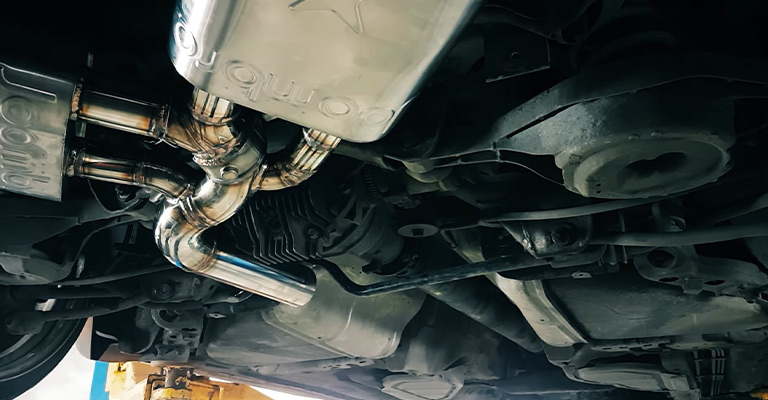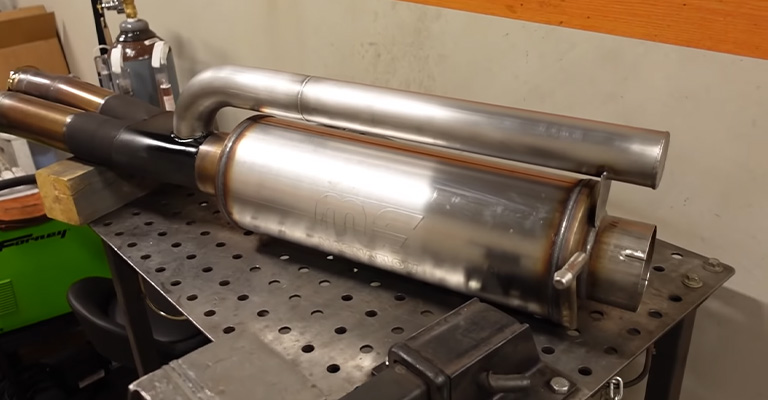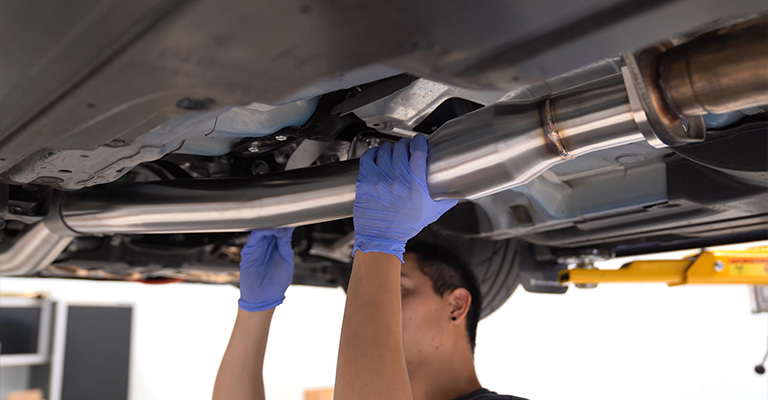To improve performance, j pipe resonators are often used in car audio and motorcycle exhaust systems. They offer several benefits, including better sound quality and increased power output.
You can calculate the size of your J pipe resonator by using its resonance frequency, which will depend on the type of exhaust system you have. If you want to increase your horsepower or torque, a J pipe resonator is a great option.
What Is A J Pipe Exhaust?
In technical terms, a J pipe is a quarter-wave resonator. In most cases, you will find this pipe welded onto your exhaust, usually near the muffler at the rear of the car, and branches out in the shape of a J. After it branches out of your exhaust system, the pipe is closed at the end of the pipe.
As a rule of thumb, this pipe is calculated to be 1/4 wavelength shorter than the frequency of your exhaust drone. Due to this reason, it is called a “Quarter Wave Resonator.”
This is an exhaust pipe that has been closed off at the end with a 90-degree bend at one end, which is welded onto the exhaust pipe of your truck. Different frequencies are associated with different RPMs, which is the idea behind the concept.
In addition, an adequately lengthened j pipe bounces off the closed end and travels back down the pipe, canceling out the frequency and eliminating the drone. Perhaps you are asking why you don’t change the muffler if the drone is so bad.
Wouldn’t it be better if you just put back the stock exhaust? Couldn’t you just put up with the drone? It’s the best of both worlds; you get your desired exhaust note, and the headache-inducing drone can be eliminated at the cost of a new muffler.
Do note that the J-pipes should be made of the same materials, gauges, and sizes as your exhaust system so they match.
J Pipe Exhaust Resonator
A J Pipe Exhaust Resonator is a device that helps reduce exhaust noise and vibration in your car or truck. You can find these resonators at most automotive stores and install them easily.

They come in different sizes to fit various vehicles, and they improve the sound and performance of your engine by reducing emissions and improving fuel economy. Some people replace their exhaust system with a resonator, while others use it on select vehicle parts for enhanced performance.
If you’re thinking about installing a J Pipe Exhaust Resonator, be sure to consult with an experienced mechanic first.
Quarter Wave Resonator
A J pipe exhaust is one of the most common resonators today. It uses a quarter wave design to create an acoustic resonance chamber where air can be expelled.

This resonator type amplifies low-frequency sounds and reduces noise pollution inside your vehicle or home office spaces. The J pipe exhaust is also known as a subwoofer muffler because it reduces bass frequencies emitted by your car’s engine or stereo speakers.
Installing a J pipe exhaust can significantly affect sound quality and overall performance.
J Pipe Design
A J pipe exhaust is a type of exhaust that uses the natural flow of air to help reduce emissions. There are many designs for j pipe exhausts, so you can find one that fits your car and personality.
You will need an exhaust system for your car for the best results.
J pipe systems are not cheap, but they may be worth it if you want to improve your gas mileage or reduce pollution levels in your community. Consider factors like noise level and appearance when choosing an exhaust system.
Benefits of a J Pipe resonator
A J pipe resonator is an essential part of any exhaust system for your car or motorcycle. They provide a variety of benefits, including reducing noise and improving performance.
If you have questions about what type of resonator would be best for your vehicle, speak to a mechanic or exhaust specialist. Many different styles and sizes are available on the market today, so finding the right one is easy peasy.
Not only do they improve the quality of your ride, but a J pipe resonator can also reduce fuel consumption by up to 10%.
How to Calculate the Size of Your J Pipe Resonator
A j pipe exhaust is essential to your car’s emission control system and is lawfully required in many states. The resonator’s size depends on your vehicle’s engine size, make, model, and year.
You can calculate the necessary dimensions using a simple formula. Get a second opinion from a qualified mechanic to ensure that you’re making the correct decision for your car’s health and safety. Resonators come in different shapes and sizes to meet all sorts of needs – get one that fits your vehicle perfectly.
Is AJ pipe a downpipe?
AJ Pipes are a type of downpipe that delivers exhaust gas to the rear of your vehicle. They can be found on some turbo models (WRX, Forester, Legacy), and there are many possibilities for where they connect in the engine bay.

Contact a professional for assistance if you have any questions or concerns about your AJ pipe.
What does AJ pipe do WRX?
Downpipes are essential for many Subaru WRX models to direct exhaust gas from the turbine wheel and wastegate away from the engine. A broken bolt or damaged downpipe can cause reduced engine performance, so it is essential to have a working downpipe if you own a WRX model.

If your downpipe is ruined, it might cause reduced engine performance in your Subaru WRX model, so inspect it regularly for damage.
Do resonators make the exhaust louder?
Resonators may increase the sound level when exhaust gases are redirected, are less baffling, and reduce back pressure, which can result in a quieter operation.
When purchasing, resonators should be considered because they will make your vehicle’s engine smoother and quieter while reducing emissions.
If you want to make your car more environmentally friendly but still enjoy a bit of horsepower under the hood, choose a resonator over an aftermarket exhaust system.
To Recap
A J Pipe exhaust is an exhaust system found on some vehicles. It reduces emissions by using the airflow from the engine to push fumes and heat out of the car.

Leave a Reply